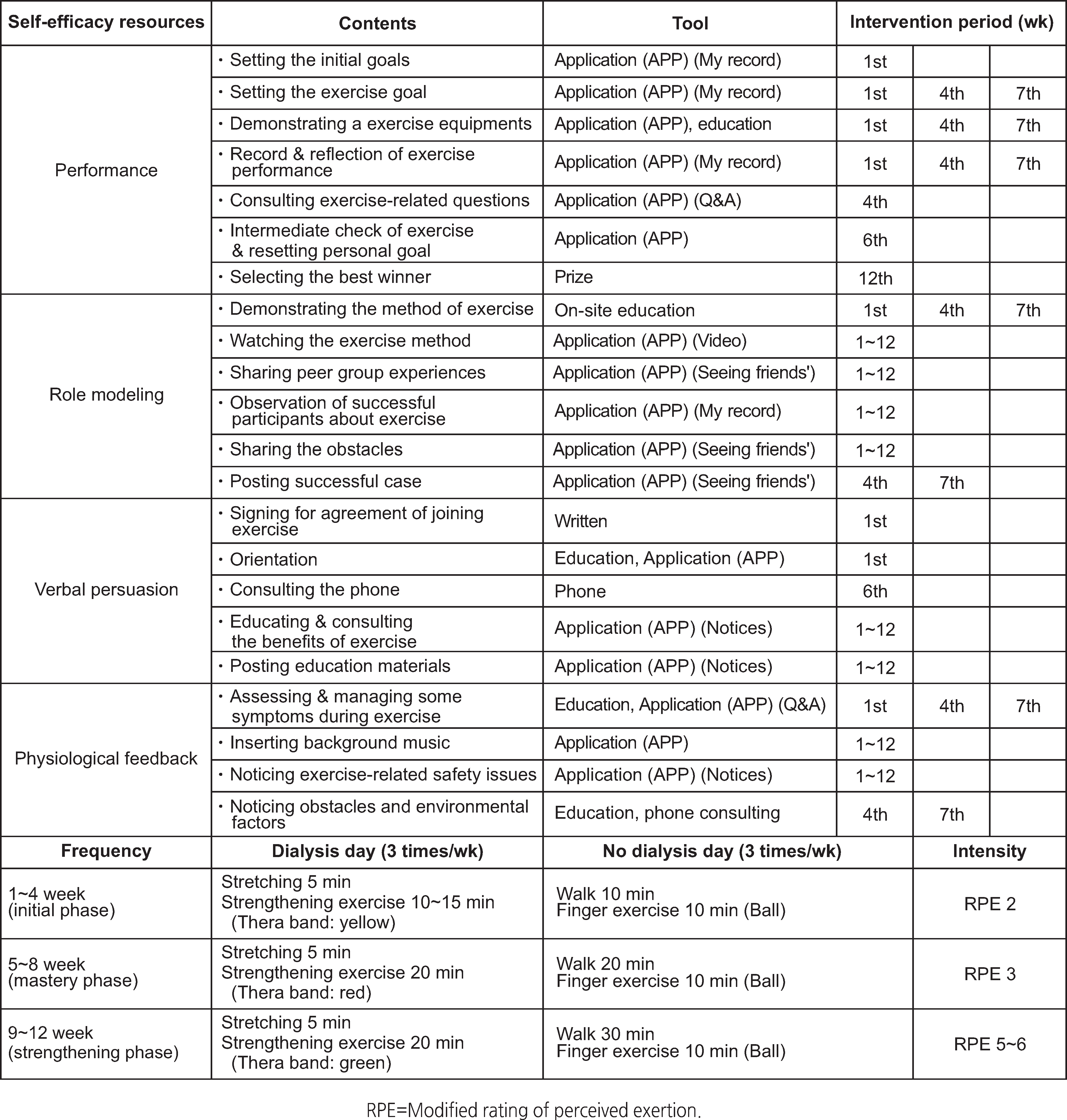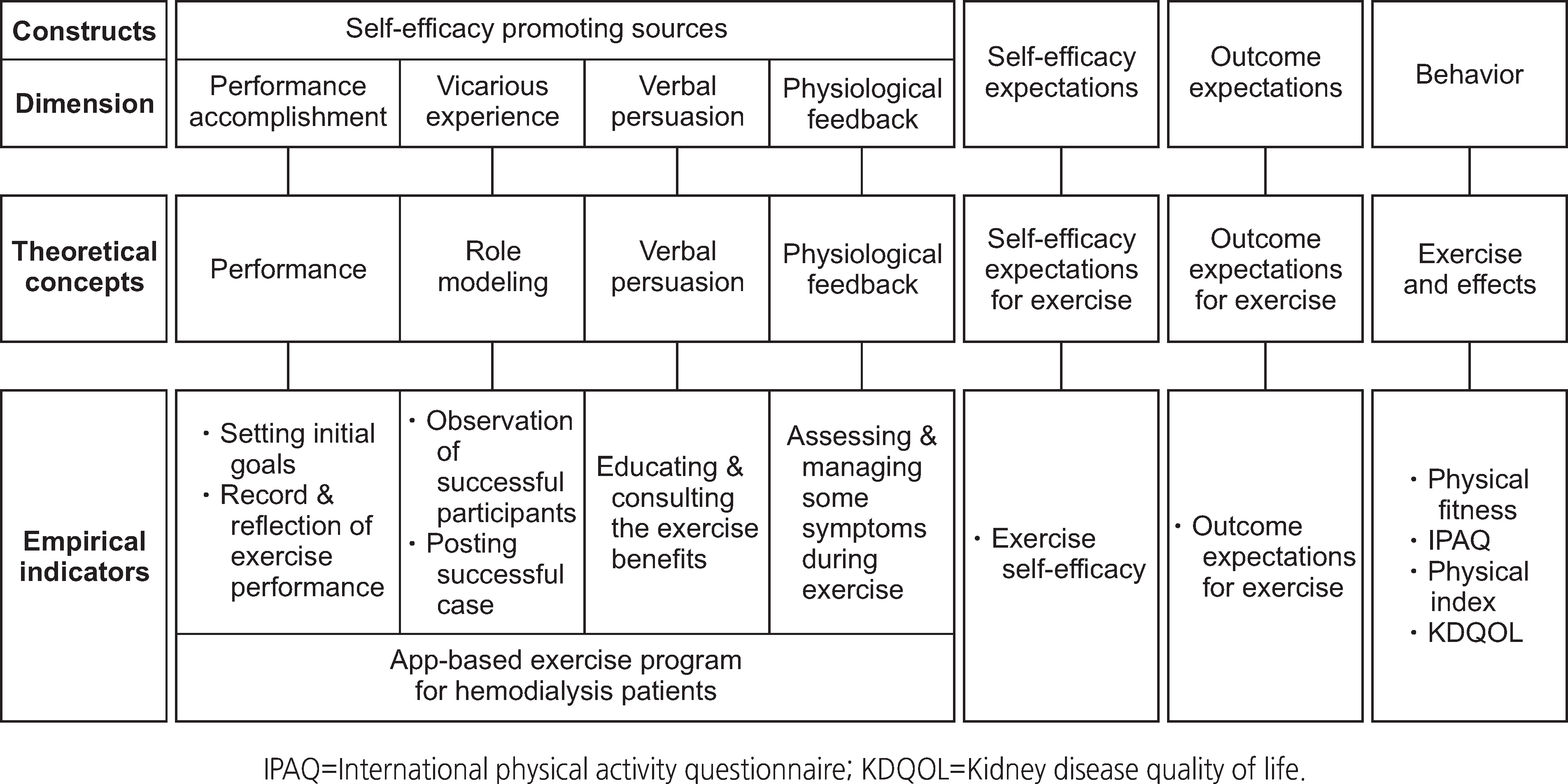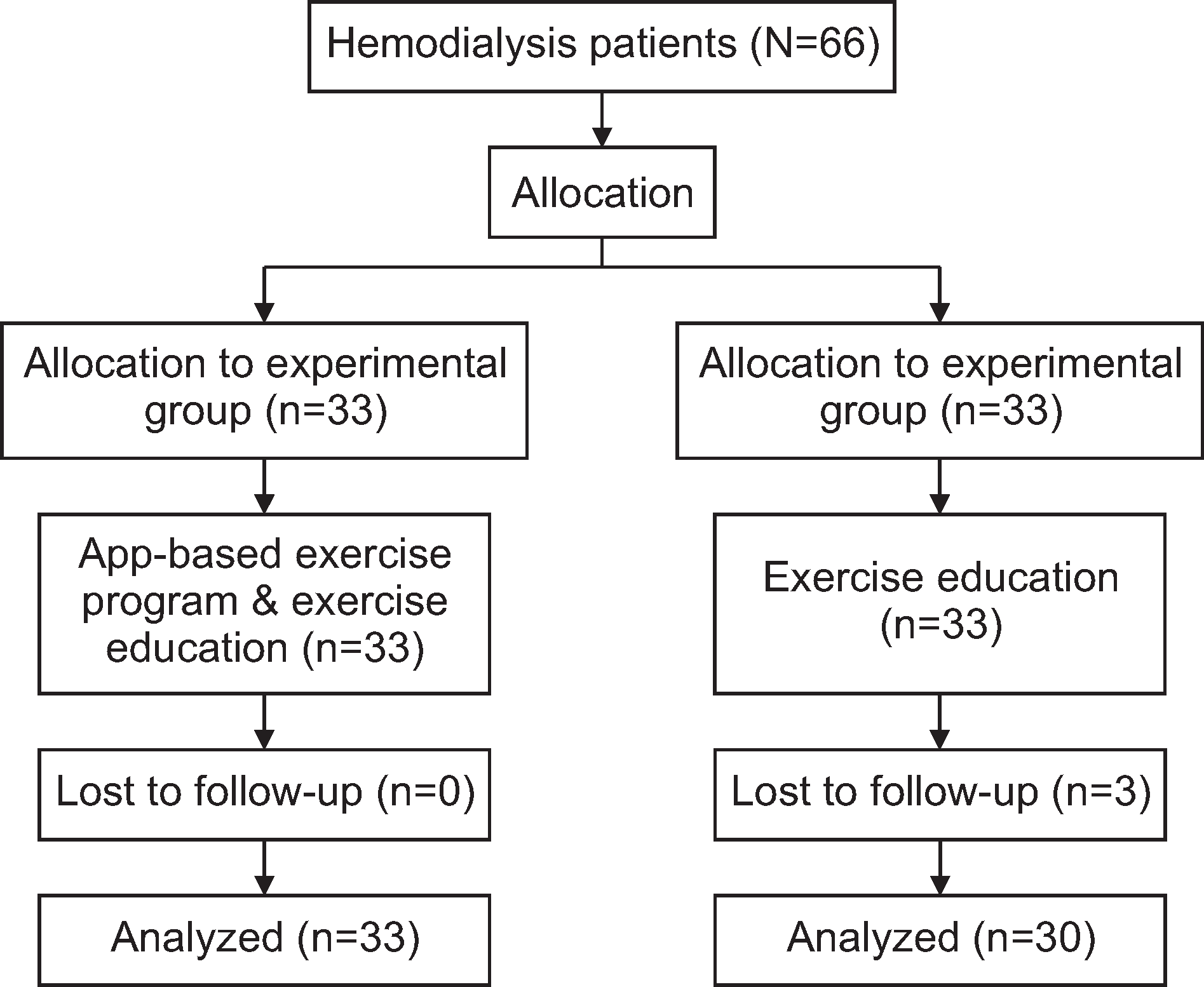Abstract
Purpose:
To examine the effects of a smartphone application-based exercise program on self-efficacy expectations (SEE) and outcome expectations regarding exercise (OEE), physical fitness, activity level, physiological indices, and health-related quality of life in a sample of hemodialysis patients.
Methods:
A quasi-experimental control group pre-test post-test design was used. Subjects were recruited from two university hospitals in G city. The subjects were assigned randomly by coin toss: 33 participants to the experimental group and 30 to the control group. A literature review and the self-efficacy theory were used to develop the smartphone program. Experts designed and verified the program to be userfriendly and in consideration of user interaction. Data were collected through a self-report pre-test post-test questionnaire and online medical records.
Results:
In the experimental group, the levels of physical fitness and physical activity were significantly improved post-test, but the scores on health-related quality of life and the physical indices did not improve. In the experimental group, the SEE and OEE post-test scores were also significantly higher than the pre-test scores, but the control group’s scores did not change.
Conclusion
The smartphone application-based exercise program based on self-efficacy theory significantly improved the level of physical fitness and activity, SEE, and OEE for hemodialysis patients. The use of this application-based exercise program for hemodialysis patients might be an effective nursing intervention tool for improving SEE, OEE, level of physical fitness, and physical activity.
Go to : 
REFERENCES
1. The Korean Society of Nephrology. Current renal replacement therapy in Korea [Internet]. Seoul: The Korean Society of Nephrology;2018. [cited2018Sep18]. Available from:. http://www.ksn.or.kr/rang_board/list.html?code=sinchart.
2. de Lima MC, Cicotoste Cde L, Cardoso Kda S, Forgiarini LA Jr, Monteiro MB, Dias AS. Effect of exercise performed during hemodialysis: Strength versus aerobic. Renal Failure. 2013; 35(5):697–704. https://doi.org/10.3109/0886022X.2013.780977.

3. Jang EJ, Kim HS. Effects of exercise intervention on physical fitness and health-relalted quality of life in hemodi- alysis patients. Journal of Korean Academy of Nursing. 2009; 39(4):584–593. https://doi.org/10.4040/jkan.2009.39.4.584.
4. Lee JY. The empirical study of exercise prescription for end stage renal failure patients [dissertation]. Seoul: SungShin Women’s University;2016. p. 1–103.
5. Gołębiowski T, Kusztal M, Weyde W, Dziubek W, Woźniews-ki M, Madziarska K, et al. A program of physical rehabilitation during hemodialysis sessions improves the fitness of dialysis patients. Kidney and Blood Pressure Research. 2012; 35(4):290–296. https://doi.org/10.1159/000335411.

6. Johansen KL, Painter PL, Sakkas GK, Gordon P, Doyle J, Shubert T. Effects of resistance exercise training and nan-drolone decanoate on body composition and muscle function among patients who receive hemodialysis: A randomized, controlled trial. Journal of the American Society of Nephrology. 2006; 17(8):2307–2314. https://doi.org/10.1681/ASN.2006010034.

7. Lee JY, Oh JE, Choi SW. The influence that the complex action program reaches on the strength and arteriosclerosis of the female end-stage renal failure. Korean Journal of Sports Science. 2011; 20(2):841–848.
8. Suh MR, Jung HH, Park JS. The effects of an exercise training in hemodialysis patients. Journal of Korean Biological Nursing Science. 2001; 3(1):29–40.
9. Levendoğlu F, Altintepe L, Okudan N, Uğurlu H, Gökbel H, Tonbul Z, et al. A twelve week exercise program improves the psychological status, quality of life and work capacity in hemodialysis patients. Journal of Nephrology. 2004; 17(6):826–832.
10. Resnick B, Zimmerman SI, Orwig D, Furstenberg AL, Magaziner J. Outcome expectations for exercise scale: Utility and psychometrics. The Journals of Gerontology. Series B, Psychological Sciences and Social Sciences. 2000; 55(6):S352–S356. https://doi.org/10.1093/geronb/55.6.s352.
11. Kim AL. Effects of structured arm exercise on arteriovenous fistula stenosis in hemodialysis patient. Journal of Korean Biological Nursing Science. 2012; 14(4):300–307. https://doi.org/10.7586/jkbns.2012.14.4.300.

12. Lee SB, Jeong PY, Lee MH. ‘Daily oral motor exercise for 15 minutes’ for cerebral palsy: A case report for the mobile application development. AAA Research & Practice. 2015; 3(1):81–90. https://doi.org/10.14818/aac.2015.6.3.1.81.
13. Estrin D, Sim I. Open mHealth architecture: An engine for health care innovation. Science. 2010; 330(6005):759–760. https://doi.org/10.1126/science.1196187.

14. Resnick B. Theory of self-efficacy. Smith M, Liehr PR, editors. Middle Range Theory for Nursing. 2nd ed. New York: Springer;2008. p. 183–204.

15. Bandura A. Self-efficacy: The exercise of control. New York: W.H. Freeman and Company;1997. p. 1–592.
16. Resnick B, Palmer MH, Jenkins LS, Spellbring AM. Path analysis of efficacy expectations and exercise behaviour in older adults. Journal of Advanced Nursing. 2000; 31(6):1309–1315. https://doi.org/10.1046/j.1365-2648.2000.01463.x.

17. Heyward VH. Advanced fitness assessment and exercise prescription. 6th ed.Kim JH, Kang IW, Kim WJ, Kim CH, Yoon BG, Lee DT, et al., translators. Seoul: Hanmi Medical;2011. p. 98–151.
18. Dunbar CC, Robertson RJ, Baun R, Blandin MF, Metz K, Burdett R, et al. The validity of regulating exercise intensity by ratings of perceived exertion. Medicine and Science in Sports and Exercise. 1992; 24(1):94–99. https://doi.org/10.1249/00005768-199201000-00016.

19. Hoeger WWK, Hoeger SA. Fitness and wellness. 9th ed.Go KJ, Go SK, Kim KJ, Park SK, Shin WT, Yang JO, et al., translators. Seoul: Hanmi Medical;2008. p. 69. 98,111,151.
20. Duncan PW. Balance: Proceedings of the APTA Forum. Alexandria: American Physical Therapy Association;1990. p. 2.
21. Rus R, Ponikvar R, Kenda RB, Buturović-Ponikvar J. Effects of handgrip training and intermittent compression of upper arm veins on forearm vessels in patients with end-stage renal failure. Therapeutic Apheresis and Dialysis. 2005; 9(3):241–244. https://doi.org/10.1111/j.1774-9987.2005.00263.x.

22. Jeon JH, Kim K. Consumer’s needs for development of smart-phone application for self care performance of patients with chronic hepatitis B. The Journal of the Korea Contents Association. 2016; 16(4):729–740. https://doi.org/10.5392/JKCA.2016.16.04.729.

23. Shin YH, Jang HJ, Pender NJ. Psychometric evaluation of the exercise self‐efficacy scale among Korean adults with chronic diseases. Research in Nursing and Health. 2001; 24(1):68–76. https://doi.org/10.1002/1098-240x(200102)24:1<68::aid-nur1008>3.0.co;2-c.

24. Choi HY, Yang SJ. Effects of walking program based on social cognitive theory for office workers. Korean Journal of Adult Nursing. 2013; 25(6):712–724. https://doi.org/10.7475/kjan.2012.24.6.712.

25. Oh JY, Yang YJ, Kim BS, Kang JH. Validity and reliability of Korean version of international physical activity questionnaire (IPAQ) short form. Korean Journal of Family Medicine. 2007; 28(7):532–541.
26. Hemodialysis Adequacy 2006 Work Group. Clinical practice guidelines for hemodialysis adequacy, update2006. American Journal of Kidney Diseases: The Official Journal of the National Kidney Foundation. 2006; 48(Suppl 1):S2–S90. https://doi.org/10.1053/j.ajkd.2006.03.051.
27. Hays RD, Kallich JD, Mapes DL, Coons SJ, Carter WB. Development of the kidney disease quality of life (KDQOLTM) instrument. Quality of Life Research. 1994; 3(5):329–338. https://doi.org/10.1007/bf00451725.
28. National Kidney Foundation. KDOQI clinical practice guideline for hemodialysis adequacy: 2015 update. American Journal of Kidney Diseases: The Official Journal of the National Kidney Foundation. 2015; 66(5):884–930. https://doi.org/10.1053/j.ajkd.2015.07.015.
29. Park HJ, Kim S, Yong JS, Han SS, Yang DH, Meguro M, et al. Reliability and validity of the Korean version of kidney disease quality of life instrument (KDQOL-SFTM. The Tohoku Journal of Experimental Medicine. 2007; 211(4):321–329. https://doi.org/10.1620/tjem.211.321.
30. Irvine AB, Russell H, Manocchia M, Mino DE, Cox Glassen T, Morgan R, et al. Mobile-Web app to self-manage low back pain: Randomized controlled trial. Journal of Medical Internet Research. 2015; 17(1):e1. https://doi.org/10.2196/jmir.3130.

31. Kim TU, Kim SC, Cho EH. The effects of using m-Health app to the body composition, blood and related variable of exercise adherence of middle-aged obese female. The Korean Journal of Physical Education. 2015; 54(2):407–419.
32. Choi YH. Effects of smart phone app-based walking exercise program for taxi drivers [dissertation]. Gwangju: Chonnam National University;2015. p. 1–86.
Go to : 
 | Figure 2.Smart phone app-based exercise program applying self-efficacy resources for hemodialysis patients. |
Table 1.
Homogeneity Test of Characteristics and Research Variables (N=63)
Table 2.
Effects of Application-based Exercise Program on Research Variables (N=63)




 PDF
PDF ePub
ePub Citation
Citation Print
Print




 XML Download
XML Download